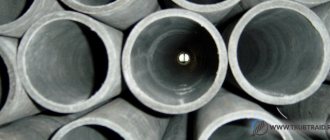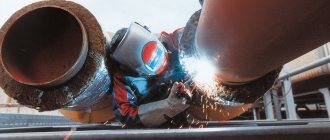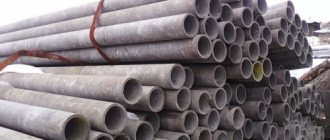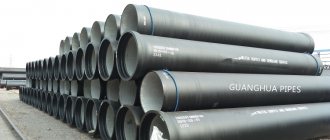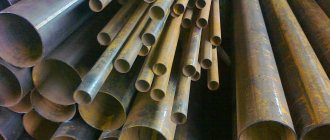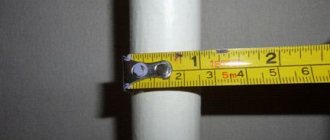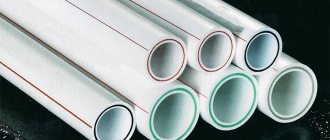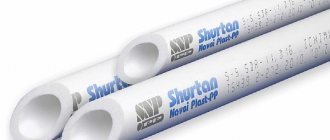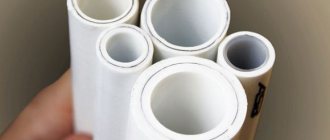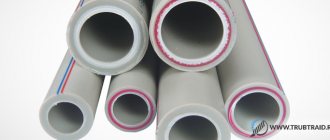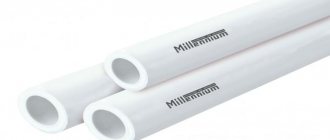The appearance of polypropylene pipes on the Russian market turned out to be very timely, when in most houses built under Soviet rule, metal water supply and heating pipes began to deteriorate because they had completely served their purpose.
The period of some distrust in the new plastic pipes did not last long. Consumers appreciated the quality, aesthetics and operational advantages of polypropylene pipes.
Today we can confidently state that the time-tested polypropylene pipes have been extremely successful, and they have become a more advantageous alternative to pipes made from other materials. What are the requirements of regulatory documents for these products, and how to choose the right pipes?
Today, polypropylene pipes are the leaders in the Russian market in terms of demand.
Characteristics and GOSTs
Among all the plastic channels, it is best to use polypropylene for creating heating circuits. Polyvinyl chloride and polyethylene are more used in cold water supply and wastewater disposal. Because they are too soft. According to consumer reviews, the advantages of polypropylene products are their strength, resistance to aggressive substances and lightness.
In addition, the channels in question have:
- resistance to significant pressure levels;
- heat resistance;
- low thermal conductivity;
- anti-corrosion properties;
- long-term operation.
The channels in question maintain high pressure levels. They can be used to solve various problems. Note that the permissible pressure is related to the temperature of the medium. The higher it is, the lower the value of this indicator.
The bulk of polypropylene products maintain pressure levels from four to six atmospheres. Provided that the water is heated to no more than seventy degrees.
The channels in question can operate normally at an ambient temperature of minus fifteen degrees. It is unlikely that you will have to use the channels in such conditions. But this property clearly demonstrates their reliability.
Products have the following temperature indicators:
- melting - from one hundred and forty to one hundred and seventy degrees;
- polymer softening - from one hundred ten to one hundred and forty degrees;
- the appearance of fragility - from minus five to minus fifteen degrees.
The above properties show that the product is excellent for creating heating circuits. Note that heating of products to the softening temperature can only occur if the carrier is heated to ninety-five degrees.
In essence, we are talking about emergency situations that occur rarely and do not last long. Therefore, they will not cause significant harm to the polymer.
Condensation does not form on the surface of the pipes. This is due to the low thermal conductivity of the material. During operation, the structures will be heated to approximately the temperature of the carrier.
Due to their anti-corrosion properties, the products are resistant to chemicals. Prolonged contact with liquid also does not have a detrimental effect on the integrity of the channels. The impurities in the carrier are not capable of causing damage to polypropylene. Only concentrated acids can cause significant damage to products. But in real operating conditions this is almost impossible.
The service life of the pipes is fifty years. Naturally, such a duration of operation is possible only if installation rules are observed and high-quality maintenance of the entire heating circuit is observed.
Fifty years is quite a long time for products for this purpose. For example, steel products last no more than twenty years.
The service life of polypropylene channels directly depends on the pressure level in the circuit, its design and temperature conditions. In addition, the wear resistance of products is affected by the quality of the fittings used to assemble the circuit.
Products must meet certain standards. There are documents regulating the characteristics, installation and design rules of systems made of polypropylene channels.
We are talking about the following standards:
Important points
- The deviation of pipes in a vertical position should not exceed 2 mm (per 1 m of length).
- The clamp must not be placed in the area where pipelines are connected to each other.
- When sealing fasteners, it is strictly forbidden to use wood plugs or welding.
- Riser pipes in industrial buildings are attached every 3 m (according to SNiP). SNiP is a set of regulations devoted to construction.
- Riser pipes in residential buildings are fixed if the height of one floor is over 3 m. This applies to steel pipelines.
- Plastic sewer pipes should be strengthened, not forgetting the slope.
Before finally installing the clamps, it is necessary to calculate the connections with the pipes, with the exception of soft types of fixation. For socket connections, rubber rings are used. Compensation type pipes are used only once.
The gap between the fastenings of polypropylene pipes is calculated during design. This step, coupled with rigid fixation, ensures longer operation. In this situation, fasteners that have a rubber gasket in their design will come in handy.
The distance between the fastenings of polypropylene pipes according to SNIP directly depends on:
- temperature regime of the distilled substance;
- content of aluminum or fiberglass in the pipe wall;
- coefficient of linear expansion in a polypropylene pipeline;
- thickness, diameter and material of pipe manufacture;
- additional loads.
Ignoring these factors will negatively affect the service life and throughput of the pipeline. If the distance between the fasteners is too large, the supports will become pinched and the polypropylene pipes will bend, which will lead to the destruction of the entire system.
Which diameter to choose
When designing a heating circuit in a private house or apartment, it is important to take into account many nuances. First of all, decide on the diameter of the channels. The cross-sectional indicator of structures is directly related to the permissible operating pressure. There are many options for channel diameters.
You can choose products with the following cross-section:
- Over 200 mm. Such products are used to create heating circuits in large buildings. For example, in hospitals, schools or hypermarkets.
- From 25 to 32 mm. Used to create a central heating circuit in multi-storey buildings.
- From 20 to 25 mm. This option is ideal for installing a heating system in private homes. The main circuit is mounted using channels with a cross-section of twenty millimeters. For the construction of risers, structures with a cross-section of twenty-five millimeters are used.
- Up to 16 mm. This type is used in the creation and installation of “warm floors”. To solve the problem you need to use fittings.
Selecting materials
Before laying a sewer system, it is necessary to choose the right pipes. The materials used for the installation of internal and external sewage systems are different. The yard (external) sewer pipeline combines discharges from a house or group of houses. Through it, wastewater is discharged into the external sewerage network if there is a centralized system. A septic tank is being built for sewerage in a private house. Until recently, the industry produced pipes for external sewerage:
- cast iron;
- steel;
- asbestos-cement;
- ceramic.
Today, the leading place in the building materials market is occupied by pipes for external installation made of plastic due to their availability, lightness and ease of installation. To understand which pipes are best to use for external sewerage on your site, let’s take a look at their advantages and disadvantages:
- Polyethylene is durable, flexible, which reduces the number of joints during installation, and impact-resistant.
- Polypropylene is stiffer than polyethylene, can withstand high temperatures and pressure, therefore they are often used when installing hot water and heating pipelines. Manufacturers guarantee 50 years of service if used correctly.
- Polyvinyl chloride (PVC) pipes of medium hardness are laid to a depth of 2 to 6 m. The maximum temperature of the wastewater should not exceed 40ºC. A PVC pipe can crack even with a slight impact.
Plastic pipes are smooth inside, so they do not accumulate deposits and are resistant to any aggressive substances found in household wastewater and soil. For external sewerage in a private house, you can use pipes with a diameter of 110 mm. Larger diameter pipes are used for drainage of wastewater from high-rise buildings or industrial facilities
Please note that the sewer pipe for external installation is marked every 50-100 cm. It indicates the outer diameter, length, name of material, manufacturer and permissible pressure
To install external sewerage from plastic pipes, select the necessary shaped parts:
- couplings;
- knee;
- plugs and more.
Replacement and how to solder
To change faulty channels in an apartment building, you need to coordinate this procedure with the housing office. His employees must shut off the riser. Only after this can you begin to complete the task. If the replacement of structures is not caused by an accident, then the procedure must be performed during the inter-heating season.
When replacing pipes, be sure to choose products whose diameter is no less than that of the dismantled channels.
Schematically, the work looks like this:
- Docking of structures to risers.
- If you need to replace the risers, install a jumper. Otherwise, this will lead to the stoppage of the entire riser.
- After completing the installation of new structures, test the circuit for leaks. To do this, you need to test by releasing the media with a pressure that exceeds the working pressure by one and a half times .
When installing channels, soldering must be used. This procedure is performed using special soldering machines. In addition, you will need a pipe cutter, level, tape measure and marker.
Remember that the duct and fitting must be heated at the same time.
The table below will help you complete the task correctly.
| Pipe outer diameter, mm | 16 | 20 | 25 | 32 | 40 | 50 | 63 | 75 | 90 | 110 |
| Distance to mark, mm | 13 | 14 | 15 | 16,5 | 18 | 20 | 24 | 26 | 29 | 32,5 |
| Heating time, s | 5 | 6 | 7 | 8 | 12 | 18 | 24 | 30 | 40 | 50 |
| Technological pause no more than s | 4 | 4 | 4 | 6 | 6 | 6 | 8 | 8 | 8 | 10 |
| Cooling time, min | 2 | 2 | 2 | 4 | 4 | 4 | 6 | 6 | 8 | 8 |
You need to note the heating time. After it has expired, connect the channel and the fitting. If the technology is violated, the quality of the joint will be extremely low. If molten polymer appears at the joint, the connection is made correctly.
Open laying and fastening of pipes
This method is less labor intensive, it is simpler and more versatile, so it is used much more often. There are two varieties of this method: in one, the pipe is fixed in a clamp motionless, in the other, it has the ability to slide in the longitudinal direction. For these methods, fastening clamps for sewer pipes of various types are used.
In addition to fasteners, each method uses sound-absorbing clamps or couplings to reduce the noise emitted by sewage as it passes through the pipe.
The selection of the diameter of the clamps requires special attention: if you choose products that exactly replicate the diameter of the pipe, the pipeline will not have freedom in the fastening points, and in the event of thermal deformation it may be damaged.
A rigid type of fastener can only be used in heated rooms with a constant temperature, since its use does not make it possible to compensate for temperature deformations that the system experiences when changes in this area.
In general, the installation process when using both methods looks similar and, having mastered it, you can install the sewerage system quickly and efficiently. Here are short instructions on how to do it.
Marking
Fasteners installed at the branch
At this stage, according to the drawn up project, the pipe laying route is marked on the walls. The laid line corresponds to the axis of the pipe, and this should be adhered to in further stages. The places where fasteners will be installed are also marked.
Particular attention is paid to points where there are branches and branches, where the presence of supports is mandatory
The distance between the points where the fasteners will be installed depends on the diameter of the pipe: it is believed that for strong fixation, the distance between the clamps should not be less than ten times its diameter.
Installation of fasteners
If possible, the clamp for securing sewer pipes is installed at a minimum distance from the wall. This is done in order to reduce the loss of usable area and reduce the risk of damage to the pipeline. If sliding fastening is planned, special inserts are inserted into the clamps. If they are missing, you should round off the edges of the clamp with a special tool in order to avoid damaging the pipe with its sharp edges. Fastening the clamps to the wall is carried out using self-tapping screws, sometimes they are included in the design of the clamp.
Pipe clamp
Pipe installation
Once the fasteners are prepared and installed, you can begin installing the pipes. This procedure is not complicated: the pipe is inserted into the clamp, and depending on its design, it simply snaps into place or is fixed with a metal pin.
Correct and high-quality fastening of sewer pipes will ensure proper and long-term operation of the entire system. Carrying out work independently, with sufficient mastery of skills, can give results that are practically not inferior to the actions of professionals, while also allowing you to achieve certain savings.
Reinforced polypropylene pipes
Initially, conventional polypropylene structures were used to create heating systems. But they have not proven themselves to be the best.
Plus, the duration of use was, as a rule, shorter than what the manufacturers claimed. In addition, under the influence of high pressure and temperature conditions, the products began to deform.
To eliminate these defects, manufacturers began to reinforce structures. This solution made it possible to significantly improve the properties of the channels. Nowadays, reinforced pipes are mainly used. They are ideal for this task
There are types of reinforced products:
- Aluminum. The products are quite popular. Aluminum foil helps protect the polymer from excessive expansion. It is placed inside the polypropylene or outside the channel. When joining such structures, they must be cleaned. Otherwise, the material will begin to delaminate.
- Fiberglass. This product is durable and high quality. The monolithic design makes the products especially reliable. Unlike the previous version, they are cast. Therefore, soldering and joining of these structures is much easier. They do not need to be stripped before installation.
The reinforcement procedure reduces the effects of thermal expansion. However, it does not eliminate them completely. It is best to use fiberglass reinforced structures.
How to calculate the number of fasteners for polypropylene?
Support for polypropylene pipes.
Polypropylene pipes have standards for the number of fasteners per unit length. This amount depends on the diameter of the pipe and temperature conditions. For clarity, we present this data in table form:
| Pipe diameter, mm | Distance between fasteners, mm. | ||||||
| 20°C | 30°С | 40°C | 50°C | 60°C | 70°C | 80°С | |
| 20 | 600 | 600 | 600 | 600 | 550 | 500 | 500 |
| 25 | 750 | 750 | 700 | 700 | 650 | 600 | 550 |
| 32 | 900 | 900 | 900 | 800 | 750 | 700 | 650 |
| 40 | 1000 | 1000 | 900 | 900 | 850 | 800 | 750 |
| 50 | 1200 | 1200 | 1100 | 1100 | 1000 | 950 | 900 |
| 63 | 1400 | 1400 | 1300 | 1300 | 1150 | 1150 | 1000 |
| 75 | 1500 | 1500 | 1400 | 1400 | 1250 | 1150 | 1100 |
| 90 | 1800 | 1600 | 1500 | 1500 | 1400 | 1250 | 1200 |
Now you just need to divide the total footage of the pipe by the distance indicated in the table and you will get the number of fasteners. The location of the fasteners needs to be considered separately. Typically, this is done during the project creation process. There is no need to skimp on supports; they are needed to protect pipelines from deformations that occur under the influence of temperature.
Types of polymer pipes used in household plumbing systems
The use of polymer pipes for plumbing is allowed by SNiP 2.04.01−85* “Internal water supply and sewerage of buildings”, which legitimizes in clause 10.1* of section 10 “Pipelines and fittings” the use of cold and hot water for internal pipelines of all water supply networks of pipes and fittings made of various plastic materials, including:
Polypropylene;
GOST R 52134—2003 “Thermoplastic pressure pipes and connecting parts for them for water supply and heating systems” in Table 26 establishes the service classes of polymer pipes:
- Class 1 - for hot water supply (operating temperature 60 0 C);
- Class 2− for hot water supply with an operating temperature of 70 0 C;
- Class 3 - for low-temperature underfloor heating with a temperature of 60 0 C;
- Class 4 - for high-temperature floor and low-temperature radiator heating with a temperature of 70 0 C;
- Class 5 - for high-temperature radiator heating with a temperature of 90 0 C;
- Class XB - cold water supply.
The scope of application of plastic pipes depends on the technical characteristics of the materials used. The most popular among users of household plumbing fixtures are:
- Pipes made of low pressure polyethylene (LDPE) and high pressure polyethylene (LDPE);
- Pipes made of polypropylene modification, called “random copolymer”, designated PPRC or PPR.
Types of clamps
In plumbing, there are the following types of fastening units for fixing sewer networks:
Types of clamps for fixing pipelines
- Crimping clamps, with the help of which you can not only fix, but also crimp the junction of pipes and fittings, insuring the tightness of the interface.
- Guide clamps, which are used in the process of positioning the pipeline relative to the supporting surface. These are markers rather than fastening units.
- Support clamps, with the help of which sewer pipes are secured to the wall. Such fasteners are equipped with rubber compensators for vibration and linear deformation.
- Safety clamps that are installed in difficult areas that require additional “support”.
The pipe is fixed with a support clamp
Moreover, all of these types of clamps require two schemes for attaching pipelines to the supporting surface: rigid and floating.
And the first (rigid) fixation option is carried out using crimp or support clamps, which are placed under the pipe socket or placed on the fitting body. The main task of such fasteners is to securely fix the interface between sections of pipeline or pipes and fittings.
The second (floating) fixation option is implemented using guides or support clamps. The diameter of the tie of the fastening element, in this case, is always greater than the outer diameter of the pipe, which can shift in the longitudinal direction.
Polyethylene pipes for plumbing
Polyethylene pipes are used in pipeline systems with a low temperature of the transported working fluid. Polyethylene pipes are not heat-resistant; they begin to soften already at 80 0 C, therefore the standards provide the following “frameworks” for their use:
- For pipelines of cold domestic drinking water supply and sewerage at operating temperatures from zero to 40 0 C, pipes are used in accordance with GOST 18599-2001 “Polyethylene pressure pipes. Technical conditions". The use of these pipes in hot water supply and heating systems is not allowed;
- For hot water supply and heating with water temperatures up to 95 0 C, pipes made of cross-linked polyethylene are used, as they are more heat-resistant. Installation is carried out in accordance with the Code of Rules SP 41−109−2005 “Design and installation of internal water supply and heating systems of buildings using cross-linked polyethylene pipes.”
Hiding pipes in the wall step by step instructions
Often owners want to install polypropylene pipes in the wall, and for good reason. This is the best option from an aesthetic point of view. But before starting work, a lot of questions arise: how the walled pipes will behave; how to install. Let's look at everything in order.
Is it possible to install PP pipes in the wall?
Polypropylene is a material that has high resistance to chemicals and corrosion. Therefore, installing pipes in the wall is quite acceptable
In order for the communication system to last for a long time, it is important when laying to leave the necessary space gap for the expansion of the hot water pipe. In addition, the system itself should be as monolithic as possible, with the least number of connections
The pipe along its entire perimeter must be additionally protected with thermal insulation. This can be corrugated cardboard, glass wool, mineral wool or other insulation. This way you will protect the structure from fogging.
It is important to provide in a closed communication system the possibility of free access to taps (valves). Usually special doors or hatches are installed in this place. . Laying PP pipes in the wall
Laying PP pipes in the wall
We install pipes in the wall
Any installation work begins with marking. You can do it with a simple pencil. Next, proceed to the main work:
- Using a grinder (perforator), you need to make 2 parallel grooves in the wall strictly according to the markings - grooves. To work with a grinder, you should use a disk with diamond-cut teeth or a simple disk for cutting stone.
- Using a chisel or hammer drill, remove the material between the 2 markings, connecting them into one.
- A polypropylene structure is inserted into the finished grooves. The polypropylene pipes in the groove are covered with cement mortar on top.
- The final finishing is done with plaster or other building material.
The final action, an hour after installation, is to test the system. The pipes must be filled with water and checked for leaks, sagging and other malfunctions in the operation of the water supply system. If none are found, congratulations, you have correctly attached the PP pipes.
Polypropylene pipes for plumbing
Polypropylene is a more heat-resistant material compared to polyethylene. The temperature at which polypropylene begins to soften is 140 0 C, which exceeds the maximum temperature of water in municipal systems set out in regulatory documents (95 0 C). Therefore, the scope of application of polypropylene pipes is much wider; they are used in all engineering communications, including heating and hot water supply.
The most in demand are polypropylene pipes made from a static copolymer with ethylene, called random copolymer PP-R (PP-R or PP type 3). Although GOST R 52134-2003 allows the use of other polypropylene raw materials, the random copolymer with the trade name PPRC is unrivaled due to its versatility of use and temperature resistance up to 110 0 C.
Polypropylene pipes are divided into quality categories in accordance with the nominal pressure (PN) for which they are designed, which allows users to correctly navigate when choosing materials for installing pipeline systems:
- Grade PN 10 is intended for use in systems with a pressure of 1.0 MPa (in the old system of units, such pressure would correspond to a pressure of 10 atm). Scope of application: cold water supply up to +20 0 C in external water supply systems, for fire fighting and irrigation. Used in heated floors with a coolant temperature not exceeding 45 0 C;
- Brand PN 16 is the same, only the nominal pressure is higher and is 1.6 MPa at temperatures up to 60 0 C;
- Brand PN 20 - operating pressure 2.0 MPa, temperature up to 80 0 C. Used for hot water supply and cold water supply;
- Grade PN 25 is assigned to specially reinforced pipes intended for heating and hot water supply at a temperature not exceeding 95 0 C and a pressure of 2.5 MPa.
Closed pipe laying
The first way to lay and firmly fix sewer pipes is to hide them in the thickness of walls and partitions.
After finishing, the sewer pipes in the wall will be completely invisible, they will not “eat up” the usable area, and the risk of damage during repairs will be reduced to a minimum. This can be done if the wall material is subject to gating, with the help of which channels are laid in the wall.
In general, the instructions for carrying out this work are as follows:
- Marking. According to a pre-developed scheme for laying a sewer pipeline, a line is drawn on the walls along which the pipe will be laid; it coincides with its axis.
- Grilling. Channels – grooves – are laid along the marked lines in the wall using special tools. They are laid in such a way that the laid pipe does not experience stress, since in this place the pipe may burst.
- Pipe laying. If further plastering is intended, and for the most part it is, the entire pipe is wrapped in soft material. Also, in the right places, protection from elevated temperatures is provided with the help of thermal insulation materials, especially if the sewer pipes are made of polyethylene or polyvinyl chloride.
After completing this process, plastering and finishing can be done.
Closed pipe laying
Connection of polymer pipes
Methods for connecting plastic pipes are defined in clause 3.3.1 SP 40−102−2000 “Design and installation of pipelines for water supply and sewerage systems made of polymer materials. General requirements". Connection types:
- Socket welding;
- On the glue there is a socket;
- Mechanically.
For example, clause 7.3.2 of the Code of Rules describes the sequence of preparatory assembly and butt welding for pipes with a diameter of more than 50 mm and a wall thickness of more than 4 mm (see figure from SP).
In relation to polypropylene pipes, methods of connecting pipes and methods for their implementation are set out in SP 40−101−96 “Design and installation of pipelines made of polypropylene “Random copolymer”. Section 5. “Pipe Connection” clearly defines the type of heating device for contact welding of pipe ends and the parameters of technological operations:
- Heating time;
- Duration of technological pause;
- Cooling time.
A polypropylene pipeline must be completed only with elements from one manufacturer to ensure compatibility of the pipe and fitting in terms of their geometry and material.
Tools and accessories
For polyfusion welding, a special electrical device is used, complete with the necessary heating nozzles and a wire for connecting to the network. The temperature of the nozzles is controlled using a contact thermometer. To cut pipelines, use a special cutter equipped with a cutting roller, pipe scissors or a hacksaw. Rosma Ital pipes of the PPR Stabi type are prepared for welding using a special cutting device. To clean the ends, use a pocket knife with a sharp short blade.
When welding, you may also need alcohol, a rag made of natural fabric, a marker, a folding meter or tape measure. Parts with a diameter exceeding 50 mm are welded using a scraper and a special mounting tool.
Conclusions and recommendations
Compliance with the requirements of regulatory documentation for pipelines made of polymeric materials is necessary not only to ensure the correct installation of communications. Polymer pipes require strict adherence to the temperature regime of water or other transported medium, since the trouble-free operation of plumbing depends on this. If a system of polymer pipes is installed in a home, then installers and users must take into account the limitation specified in clause 6.1.2 of SNiP 41−01−2003 “Heating, ventilation and air conditioning.”
For heating systems with pipelines made of polymer materials, it requires automatic control of the operating parameters of the coolant in order to prevent their exceeding:
- Temperatures - above 90 0 C;
- Pressure - above 1 MPa.
Advantages and disadvantages
Reviews of the Abyssinian well and research data make it possible to highlight the following positive aspects of this source of water supply:
- small cash investment;
- high speed of construction of an Abyssinian well (from 3 to 10 hours; there is no need to involve large and expensive equipment;
- the pumping element is located on the surface of the ground, which facilitates its maintenance and repair;
- protection from the ingress of melt and flood waters due to the lack of casing; excellent quality of produced water;
- the ability to install a well directly in the house; if desired, you can install a hand pump and make a non-volatile water supply;
- The flow rate of pumped water is usually from 1 cubic meter. m per hour, which allows you to provide water to a large family.
Unfortunately, the Abyssinian well has a number of disadvantages that limit its use under certain conditions. Let's list them:
- short service life (up to 15 years, in rare cases it can reach 30 years);
- frequent expensive repairs due to silting of the filter (2 times more often than an artesian well);
- to service and replace the filter part, you have to completely dismantle the pipe, replace the mesh and re-immerse it to the required depth;
- restrictions on use on heavy rocky and clayey soils; sandy and sandy-pebble soils are best suited for normal well operation;
- This source of water supply should not be located near sewage drains and livestock yards, as well as near streams and other bodies of water.
The piezometric water level is the steady-state height of the groundwater table after the aquifer has been opened. In this case, the actual depth of the well can exceed the piezometric level by 5 meters or more. If in an Abyssinian well this figure exceeds eight meters in depth, then it is permissible to lower the pumping station a few meters to ensure normal water absorption by the installation.
Application
Instead of a summary, we will offer a short list of regulatory documentation regulating the use of plastic pipes in household plumbing:
- SNiP 2.04.01−85* “Internal water supply and sewerage of buildings”;
- GOST 18599—2001 “Polyethylene pressure pipes. Technical conditions";
- SP 41−109−2005 “Design and installation of internal water supply and heating systems of buildings using cross-linked polyethylene pipes”;
- SP 40−101−96 “Design and installation of pipelines made of polypropylene “Random copolymer”;
- GOST R 52134—2003 “Thermoplastic pressure pipes and connecting parts for them for water supply and heating systems”;
- SP 40−102−2000 “Design and installation of pipelines for water supply and sewerage systems made of polymer materials. General requirements"
- SNiP 41−01−2003 “Heating, ventilation and air conditioning.”
Preparation for installation of PP pipes
It is impossible to do plumbing with hands and pipes alone, so you should understand the heating and water supply schemes, the necessary tools, connection methods and materials used.
The assembly of a water supply system from PP pipes includes a number of traditional steps:
Stage #1. Drafting
Before purchasing material for installing heating and plumbing, you need to decide on their wiring diagram.
There are four main ways to connect batteries to the heating circuit:
- flow-through;
- with unregulated bypass;
- with valves;
- with three-way valve.
The final choice of installation option is usually determined by the financial capabilities of the apartment owners, because shut-off valves are not cheap.
Schemes with adjustable valves allow you to regulate the power of radiators separately in each room of the house without compromising the hydrodynamics of the system
The water supply system also has basic design diagrams for wiring, but there are only two of them: collector and tee (traditional in apartments).
The tee circuit is installed in apartments where a short length of pipes and a small number of simultaneously used plumbing fixtures do not lead to a drop in pressure in the general circuit
A tee circuit is also called sequential. It involves running one pipe along all plumbing fixtures, from which branches are made sequentially using a tee.
The collector circuit involves installing a flute-shaped collector at the water inlet to the house. It allows you to compactly make several bends in different directions.
The collector circuit is recommended for installation in large houses, where a drop in main pressure is possible when several plumbing fixtures are turned on simultaneously
The wiring can be done inside the walls or in the open. The first option requires detailed calculations that take into account the elongation of pipes when heated.
We advise you to familiarize yourself in more detail with the wiring diagrams for water supply pipes made from PP pipes.
Stage #2. Preparing tools
A significant disadvantage of working independently with polypropylene pipes is the need to use special tools. The price of an installation equipment kit ranges from 100 to 200 dollars.
The contents of ready-made kits may differ from one manufacturer to another. The overall price is especially affected by the power of the soldering iron and its functionality.
This set should include:
- an electric welding machine with a stand or simply a soldering iron for PP pipes;
- pipe cutters;
- shaver for removing the outer layer and aluminum from reinforced pipes;
- calibrator and chamfer for monitoring and adjusting the diameter of parts;
- nozzles for heating the elements being soldered.
In addition to special equipment, to install PP pipes you will need an adjustable wrench, a marker, a tape measure and other general household tools.
If you are planning one-time installation work, you can rent a soldering kit.
Stage #3. Selection of polypropylene fittings
PP fittings are used to weld PP pipes together in various combinations, as well as to connect them to plumbing fixtures.
These include;
- adapters;
- nipple bends;
- couplings;
- threaded couplings;
- tees;
- plugs;
- crosses;
- detachable connectors;
- Ball Valves;
- clamps.
Some tips for choosing fittings and installing pipes:
The quality of polypropylene and the wall thickness of fittings may also differ, so you need to choose them according to the marking of the pipes.
Stage #4. Selecting a connection diagram
There is a fundamental difference in soldering pipes with a diameter of up to 63 mm and from 63 mm. Pipes that are equal to or larger than this size are butt soldered, and those that are smaller are connected using the socket method.
The latter involves the formation of a joint due to the fact that the molten cut end of the pipe enters a few centimeters into the expanded socket of the fitting.
The same method is used to connect two pipes to each other using a coupling.
When connecting pipes in opposite directions, it is important that no protruding inward bulge is formed at their junction: it will impede the movement of water, lowering the pressure in the system
Depending on the presence of threaded parts, connections of PP products can be:
- detachable;
- one-piece.
Detachable connections involve soldering two threaded fittings with external and internal threads to the ends of the connecting parts.
The one-piece type includes the above-described socket connection method by soldering two polypropylene products.
To learn more about the technology of welding polypropylene pipes, follow this link.
How to care for a homemade fountain
A home fountain, like any other equipment, needs regular and timely maintenance. The basic rules for using a pumpless fountain are:
The water in the tanks must be replaced every three to four days. Otherwise it will stagnate and start to smell bad.
During use, the bottom of the bowl becomes covered with mucus. That's why it needs to be washed regularly
It is most convenient to do this together with changing the water. When installing the fountain, it is very important to leave free access to all components in advance to facilitate maintenance. If the structure is located outdoors, it would be better to move it indoors during the winter so as not to damage the parts.
Installation of pipeline in the ground
The technology involves laying a sewer pipe in the ground with a socket against the flow of wastewater, that is, away from the house. It is prohibited to shorten the pipe socket and fittings. Before laying the pipe you must:
- clean the internal cavity from possible contamination;
- check the presence of o-rings;
- prepare the necessary bends to change the direction of the pipe, if necessary.
Perhaps there is a bathhouse or other building on your site from which water needs to be drained. The pipe from this room will cut into the main system through bends. There are bends with elbow angles of 15, 30, 45 or 90º. At the junction, a round or square inspection well is made. Its walls are usually lined with baked bricks. It is enough if the inspection well is 70-80 cm wide. An inspection is installed at the pipe connection or turning point. To prevent groundwater and precipitation from entering the well, a clay castle is placed at the bottom of the well and around it. To connect pipes and fittings, it is recommended to use:
- technical petroleum jelly;
- silicone lubricants;
- liquid soap.
These products promote tightness and simplify assembly. The assembly technology is simple: the smooth end of the pipe is lubricated along the length of the joint and inserted into the socket with a seal. During installation, preference is given to double-sided O-rings (with two protrusions).
Types of plumbing wiring diagrams
In practice, wiring is done in three ways:
- using distributor tees - sequential;
- through the collector;
- with pass-through elements - sockets.
The choice of water supply layout in an apartment depends on the individual needs of the homeowner and the design features of the premises. In some cases it is appropriate to use series and collector wiring simultaneously.
Tee
This scheme for distributing water supply in an apartment is based on the transportation of cold and hot water through two central pipelines. At the locations of water collection points, outlets are installed using tees, through which water reaches the consumer.
Since after the start of water flow through any tap, the liquid pressure in the main decreases, the central pipe is selected with a larger diameter than the internal dimensions of the bends.
In addition, it is necessary to correctly position the pipe joints. It is best to arrange them in places hidden from view. For example, in closed parts of sinks, bathtubs, wall niches. There the connections will be accessible for maintenance, but will not spoil the appearance of the room.
The disadvantage of a serial connection is that the branch is completely cut off from the input in case of repair. To solve this problem, additional emergency valves can be installed, but increasing their number leads to a decrease in pressure. In addition, the tee scheme is characterized by sealing the joints into the walls. If the pipe leaks, you will have to dismantle the trim and break the wall.
Sequential wiring will be ineffective in rooms with a large number of water points on one branch. In such a section, a pressure drop will inevitably occur at the points furthest from the input, especially when several devices operate simultaneously. The consequence of such differences may be equipment malfunctions.
Collector
It is more profitable to use a collector water supply scheme in the case of a large number of water supply units in the apartment.
The main difference from the tee version is the use of a manifold. From the central riser, water is supplied to the collector, and from it to each individual plumbing fixture. Thanks to this, it is distributed evenly. Therefore, the pressure in the pipeline does not decrease at the points furthest from the input.
If repairs are necessary, only the damaged branch is cut off, and not the entire water supply. For the same reason, each branch can be mounted uniquely to suit the needs of an individual consumer. The area that supplies water to the washing machine may need to install additional filters. And they won’t be needed to operate the toilet cistern.
Separate collectors are purchased for distributing hot and cold water. Taps are installed between them and the risers to stop the water supply in an emergency or during repairs. Consumers receive water from collectors, and hot water and hot water supply are supplied to the bathtub and sinks. To the toilet and washing machine - only cold water, and to the heated towel rail - only hot water.
If there are a lot of water collection points, then several consumers can be connected to one branch of the collector using a tee circuit.
With pass-through sockets
A pass-through socket is a connector in the form of an elbow with a 90° bend, which is used to connect the water supply in the apartment. The design of the sockets includes brackets for fastening to the wall, threads on the consumer connection side and inlet holes for soldering to the pipe through which water is supplied.
To connect mixers, double sockets are produced on the strip. Such connectors are used for faucets in the bathroom or shower stall. A significant drawback is the complexity of installation - you have to solder two pipes at the same time.
We insulate communications in the basement heating pipes
The problem of insulating communications in the basement, as a rule, is not familiar to ordinary city residents. But it is very often encountered by all those who live outside the city or have a dacha (or private house) for seasonal residence. Insulation of pipelines is not only useful, but also often a necessary measure, protecting the entire building from many potential problems.
Materials for thermal insulation
Today, a variety of materials can be used to reduce heat loss and insulate heating pipes. The choice of one or another heat insulator for basement pipes will depend, first of all, on the specific requirements of the owner of the house, operating conditions and pipe sizes.
There are a huge number of thermal insulation materials on the modern market, but not all of them are suitable for heating pipes.
This point must be taken into account before purchasing this or that thermal insulation material.
Of course, the most common and traditional thermal insulators, which are used everywhere, include fibrous insulation, including mineral wool.
It can be used in a variety of conditions, and almost always the thermal insulation will be quite effective.
Materials based on mineral wool can potentially withstand extremely high temperatures, so they can be used in basements and boiler rooms.
Mineral wool.
What can be identified from the main advantages of this heat insulator?
- high level of resistance to chemicals;
- safety for humans and the environment;
- minimal water absorption (but with serious exposure to water, the insulation will lose its properties);
- small price.
Basalt wool.
Mineral wool, according to experts, is excellent for thermal insulation of external pipelines, as well as heating systems in the basement of a private house.
In recent years, derivative materials have been increasingly used: basalt wool and glass wool, which also have good performance and performance characteristics. Materials of this type are suitable for most country homeowners.
Insulation with polyurethane foam
Recently, more and more people have begun to pay attention to modern heat insulators. And one of the most popular and effective is polyurethane foam (PPU). This type of material is excellent for pipes and is, in fact, the outer shell for a water pipe (“pipe within a pipe”)
This type of material is excellent for pipes and is, in fact, the outer shell for a water pipe (“pipe within a pipe”).
Polyurethane foam significantly reduces heat loss.
This type of design not only minimizes thermal energy loss, but also gives the pipes a high level of strength.
Positive characteristics of polyurethane foam:
- the material does not contain any compounds hazardous to humans;
- high level of resistance to climate impacts;
- increased mechanical strength;
- neutral to electricity and biological influences.
Polyurethane foam insulation materials will not rot or be destroyed by chemical exposure. The only obvious drawback of the material is its high cost. In fact, only this can be considered a reason to refuse thermal insulation from polyurethane foam in the basement of a private house.
Ready-made polyurethane foam shells.
It should be noted that insulating pipes with polyurethane foam is not so easy to do with your own hands, so it is better to hire specialists for this work. In the basement of a private house, the use of polyurethane foam often does not look like a very profitable option: the cost of a single installation (for example, for one or two pipes) will be quite high, so there is no urgent need for it.
Treatment plants
In some cases, laying sewer pipes at the correct angle is not possible due to the terrain. Then a pump is installed and the sewage is removed forcibly. In addition, the problem of difficult terrain can be solved with the help of a modern deep biological treatment station (tanker), since it can be installed 2 m from the house. Aerobic bacteria process fecal matter, converting it into sludge, which is removed 1-2 times a year and used as fertilizer. Wastewater is 98% purified. The undeniable advantages of the tanker are:
- the recycling process occurs tens of times faster than in a septic tank;
- the purified liquid can be collected in a reservoir and used for watering plants;
- the installation takes up little space and the soil underneath is not contaminated.
The disadvantage of a biological installation is its high cost and the need to constantly monitor the living conditions of bacteria.
The location of the treatment plant is determined when planning the entire site. In addition to the sewage tank, the following disposal devices can be used in a private home:
- Cesspool with filter bottom. The distance from the cesspool to the water intake must be at least 30 m. It is arranged so that the contents can be pumped out using sewage disposal equipment. This type of waste collection is suitable where people do not live permanently, for example, in dachas.
- A cesspool without drainage is a sealed wastewater reservoir. The disadvantage of a sealed pit is that you will often have to turn to the services of sewer trucks.
- A septic tank consists of 2-3 chambers connected to each other, each of which has a drainage pad so that the water goes into the ground. The cleaning ability of a septic tank is 60-70%. A septic tank is built 1 m above the depth of groundwater, at a distance of 25 m from the water intake and at least 5 m from the house to avoid soil erosion.
Depending on the number of people living in the house and the daily water consumption, each site owner chooses which local device is most suitable for him.
If the above conditions are met, the system will operate efficiently without harming the environment. A properly designed and constructed sewer system will not bring you unnecessary worries and will be the key to your peace of mind.
